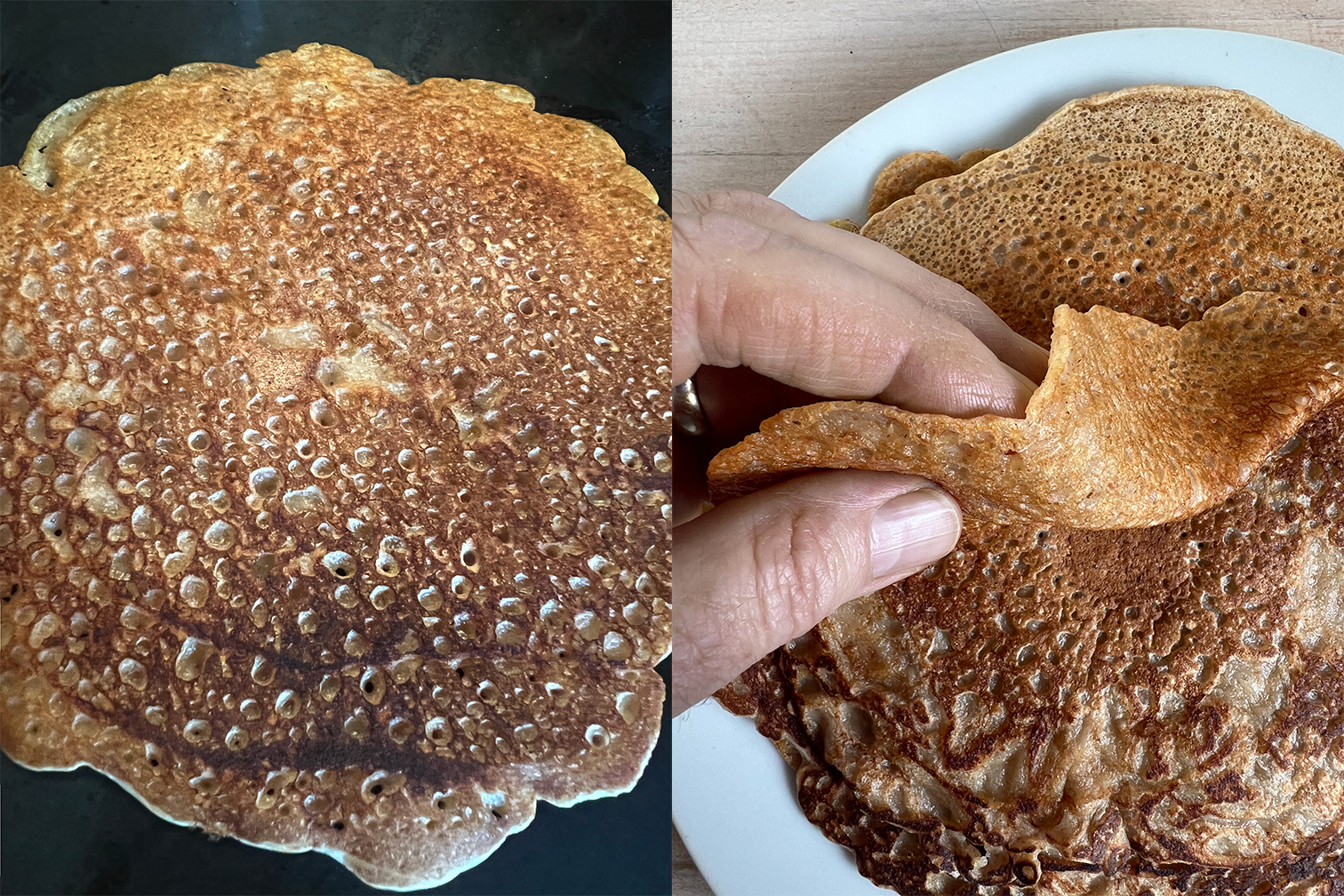Ingredients
100g spent or unrefreshed sourdough (*see note)
250g-300g cold water
100g cold milk, oatmilk, or more water
100g BakeryBits Jumbo Rolled Oats, finely-ground in the blender
50g Redbournbury Organic Wholemeal Flour
25g Matthews White Spelt Flour, or white bread/plain flour
3g fine salt
7g (1/2 sachet) Bioreal Organic Baking Powder With Pure Cream Of Tartar
15g dark brown sugar
When is a pancake not a pancake? When it’s a Staffordshire Oatcake! If you’re unfamiliar with these you might think that oatcakes are always crisp round biscuits, but these oatcakes are soft and tender, and were once long ago much more common, with variations found all over England, Scotland and Wales.
Here I’m using a Welsh bakestone to make them, as a Staffordshire bakestone is hard to find these days (apparently made of shale stone).
The very old method once used in Staffordshire and elsewhere in Britain, simply fermented fine oatmeal and water overnight, without any other ingredients. Today we’re not always thinking that far ahead so this recipe can be made very quickly, or left overnight to get more flavour, as you prefer. It has a mix of wholemeal and white flour added, as this makes them much easier to flip over.
Do increase the proportion of oatmeal to flour as you get more practice, as you increase the oatmeal just decrease the flour by the same amount.
Makes 6 medium-sized oatcakes
Method
*Note: if you don’t have sourdough it is fine to make these with dry active yeast. Just mix 50g plain flour with 50g warm water and 3g yeast, and let this bubble for 30 minutes before using.
Whisk together the sourdough, water, milk, ground oats, wholemeal flour, white flour and salt together until smooth. A Danish dough whisk makes this very easy. Then beat in the baking powder and sugar.
This can be done the night before, covered well, and left in the refrigerator or at cool room temperature overnight.
How to cook your oatcakes
Check the consistency of your oatcake mixture: it should be like single cream in its thickness, add more water or flour to adjust it to your liking. Get your bakestone hot. Have some oil ready and some paper towel at hand. Oil the surface of the stone lightly with paper towel. Then pour some oil more liberally in the centre (mop up any excess with a paper towel) and do a test teaspoonful of batter just to check the temperature and how well the oatcake will release from the surface. The stone will take a few goes to first to release the oatcake cleanly.
Be patient when you're cooking your oatcakes…
My first one stuck heavily and needed switching off and rubbing clean with paper towel (don’t wash the surface) and a BakeryBits Metal Spatula to remove any stuck bits. So what I needed to do, and you will too, is effectively "season" the surface with oil, so it gets into the surface of the metal to create a natural "non-stick" effect. Anyone who has made pancakes of any kind on an uncoated (i.e. not Teflon) steel pan will know exactly what I'm talking about. So on the second oatcake I used more oil on the hot surface, mopping up any excess oil from the edges of the bakestone, and that only stuck very little. I repeated the switching off, rubbing down the surface with paper towel, and heating it once more, then again oiled the middle of the steel liberally. Voila! It was easy from this point on, without sticking. A flat metal pallet knife was handy to free the edges and then, when brown underneath, slide the knife right underneath to make sure it isn’t sticking.
Once they’re cooked on the base and loose underneath when you check it with the spatula, you can just use the spatula to flip it over and cook the other side lightly. Then lift them onto a plate, covered with a cloth and cook the remaining mixture.
The oatcakes freeze extremely well, and only need to be thawed before use.
















